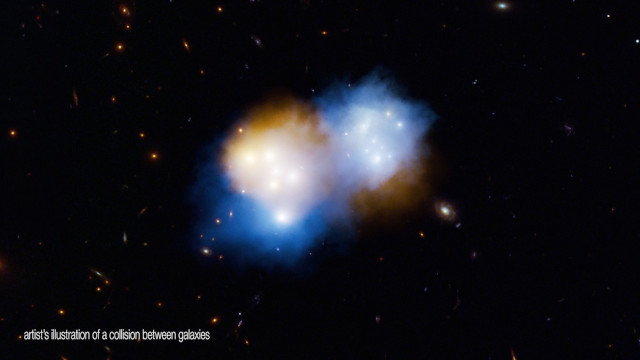
An article published in the journal “The Astrophysical Journal” reports the results of a study on the ongoing merger between two galaxy clusters that are forming a single new cluster cataloged as MACS J0018.5+1626, or simply MACS J0018.5. A team of researchers used data obtained from observations dating back even decades conducted with various space and ground-based telescopes, analyzing them to decouple the behavior of ordinary matter and dark matter.
To measure the speed of intergalactic gas composed of normal matter, they used the kinematic Sunyaev-Zel’dovich (SZ) effect. The speed of dark matter is roughly the same as galaxies. The result is that dark matter moves faster than normal matter. This result offers clues about dark matter and its behavior that are useful in studies of its nature.
Galaxy clusters can be formed by even thousands of galaxies that are linked by gravitational bonds generated by the matter that composes them. According to current cosmological models, only 15% of that matter is baryonic, or common, while the remaining 85% is made up of the mysterious dark matter. Many studies are trying to shed light on it, in some cases, based on models that don’t predict its existence and explain the observed gravitational effects in other ways.
MACS J0018.5 is a galaxy cluster that is in the process of forming from the merger of two clusters. The gravitational forces at play are colossal given the mass of matter that forms all the galaxies involved and the gas present among them. This is a useful case to study how baryonic matter and dark matter behave.
Studies of the gravitational effects generated by dark matter indicate that galaxies and dark matter behave similarly during a collision between galaxy clusters. Intergalactic gas interacts at an electromagnetic level as well, and for this reason, is slowed down. The kinematic SZ effect allows to calculate the velocity of those gas clouds.
To make the calculations, the researchers used data collected in various electromagnetic bands over many years with various space and ground-based telescopes. Jack Sayers of Caltech, the principal investigator of this study, conducted the first observations of MACS J0018.5 in 2006 using the Caltech Submillimeter Observatory (CSO), recently removed from its site on Mount Maunakea in Hawaii to be relocated to Chile.
The analysis of the data and various simulations of the behavior of galaxies and intergalactic gas in MACS J0018.5 allowed understanding step by step the processes at work. First of all, it allowed to establish that one of the original clusters is moving towards the Milky Way while the other one is moving in the opposite direction. It seems trivial but understanding the direction in which a galaxy cluster is moving already requires considerable and prolonged efforts.
Eventually, the researchers were able to decouple baryonic matter and dark matter to calculate their movements separately. Emily Silich, the study’s lead author, compared this situation to a collision between trucks carrying sand: dark matter is like the sand and flies forward as a result of the collision.
The researchers hope to conduct more studies like this one to gain new insights into the behavior of dark matter. The study involving MACS J0018.5 is a starting point for studying the different behavior of dark matter compared to baryonic matter. This way of studying dark matter in galaxy clusters may offer new clues about its nature.
At the moment, the Lambda-CDM model is the one that best describes dark matter. However, until definitive proof of its existence by identifying its particles or of its non-existence is found, each study can potentially be decisive in this type of cosmological research.

